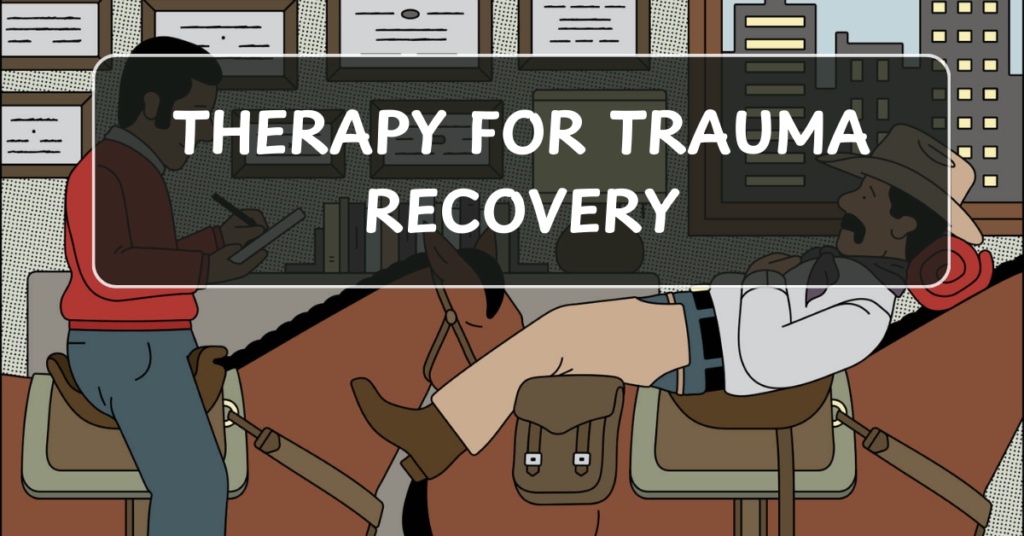
Trauma can have a profound impact on an individual’s mental, emotional, and physical well-being. Whether caused by a one-time event or prolonged exposure to distressing experiences, trauma can shape a person’s life in ways that are often challenging to overcome. Therapy for trauma recovery offers a structured and supportive environment where individuals can process their experiences, heal from the effects of trauma, and regain a sense of control over their lives. In this article, we’ll explore the different types of therapy available for trauma recovery, the benefits of therapy, and how it can support individuals on their journey to healing.
1. The Importance of Therapy in Trauma Recovery
- Why Therapy is Crucial: Trauma often leads to emotional and psychological wounds that can be difficult to heal without professional help. Therapy provides a safe, nonjudgmental space for individuals to work through their trauma, process difficult emotions, and develop healthier coping mechanisms.
- Understanding Trauma’s Impact: Trauma can affect every aspect of a person’s life—relationships, work, and overall sense of self. Therapy helps individuals understand how their trauma has shaped their thoughts, behaviors, and emotional responses, enabling them to take steps toward recovery.
- Restoring Emotional Balance: Trauma can leave individuals feeling overwhelmed, anxious, or disconnected from their emotions. Therapy supports emotional healing by teaching individuals how to regulate their emotions and develop a sense of balance and peace.
2. Types of Therapy for Trauma Recovery
- Cognitive Behavioral Therapy (CBT): CBT is one of the most widely used approaches for trauma recovery. It focuses on identifying and changing negative thought patterns that contribute to emotional distress. CBT helps individuals reframe their trauma-related thoughts, reduce anxiety, and build healthier coping strategies.
- Trauma-Focused CBT: A specific form of CBT tailored for trauma survivors, trauma-focused CBT helps individuals confront and process their traumatic memories in a safe and controlled environment. It helps reduce the intensity of trauma-related symptoms such as flashbacks, nightmares, and anxiety.
- Eye Movement Desensitization and Reprocessing (EMDR): EMDR is a specialized therapy that helps individuals process traumatic memories by using bilateral stimulation (such as eye movements or tapping). This approach helps individuals reframe their trauma memories, reduce their emotional charge, and integrate them into a healthier narrative.
- How EMDR Works: During an EMDR session, a therapist will guide the individual to recall traumatic memories while engaging in bilateral stimulation. This process helps the brain process and reframe the memory, reducing its emotional impact.
- Dialectical Behavior Therapy (DBT): DBT is particularly helpful for individuals who struggle with intense emotions and self-destructive behaviors as a result of trauma. It focuses on teaching emotional regulation, mindfulness, and distress tolerance skills. DBT also emphasizes the importance of building healthy relationships and setting boundaries.
- Core Skills of DBT: DBT teaches mindfulness, emotional regulation, interpersonal effectiveness, and distress tolerance to help individuals manage their emotions and make healthier choices.
- Somatic Experiencing (SE): SE focuses on the body’s response to trauma and works to release stored trauma from the body. This approach helps individuals become more aware of how trauma affects them physically and encourages the body to process and release pent-up tension or trauma-related energy.
- Body-Based Approach: SE uses techniques such as deep breathing, body scans, and gentle movement to help individuals reconnect with their bodies and release stored trauma energy, facilitating emotional and physical healing.
- Psychodynamic Therapy: This therapy is based on the idea that unresolved unconscious conflicts from the past can impact an individual’s emotional and psychological well-being. Psychodynamic therapy helps individuals uncover these hidden conflicts, process them, and develop healthier ways of thinking and behaving.
- Uncovering Root Causes: In psychodynamic therapy, individuals explore their past experiences and relationships to identify patterns and uncover underlying emotional issues that may have been influenced by trauma.
3. Benefits of Therapy for Trauma Recovery
- Emotional Healing and Relief: Therapy provides a safe space to express difficult emotions such as fear, anger, sadness, and shame. By processing these emotions in a healthy way, individuals can start to heal and reduce emotional suffering.
- Reducing Symptoms of PTSD: For many individuals, trauma can result in symptoms of Post-Traumatic Stress Disorder (PTSD), including flashbacks, nightmares, and hypervigilance. Therapy can help reduce these symptoms and help individuals regain control over their emotional responses.
- Improving Relationships: Trauma often disrupts relationships, making it challenging to trust others or communicate effectively. Therapy helps individuals heal from relational trauma, rebuild trust, and develop healthy communication and interpersonal skills.
- Building Coping Skills: Therapy equips individuals with practical tools and coping mechanisms to manage stress, anxiety, and triggers that arise from trauma. These skills help individuals navigate challenges and prevent further emotional distress.
- Rebuilding Self-Esteem: Trauma can significantly affect an individual’s self-worth, leaving them feeling powerless or unworthy. Therapy helps individuals rebuild their self-esteem by focusing on their strengths, resilience, and personal growth.
- Empowerment and Control: Through therapy, individuals regain a sense of control over their lives. Therapy helps individuals make sense of their trauma, reclaim their autonomy, and develop strategies for moving forward with confidence.
4. How to Choose the Right Therapist for Trauma Recovery
- Researching Qualifications and Experience: When seeking therapy for trauma recovery, it’s essential to choose a therapist who is trained in trauma-informed care and has experience working with individuals who have experienced similar types of trauma.
- Comfort and Trust: It’s crucial to feel comfortable and safe with your therapist. A strong therapeutic relationship is essential for healing, so trust your instincts when choosing a therapist and seek someone who makes you feel heard and understood.
- Therapist’s Approach: Different therapists use different therapeutic modalities. It’s important to consider what type of therapy resonates with you, whether it’s talk therapy, body-based approaches, or trauma-specific techniques. Many therapists offer a free consultation, which can help you determine if their approach aligns with your needs.
5. Overcoming Barriers to Trauma Therapy
- Fear of Reliving Trauma: One of the most significant barriers to trauma therapy is the fear of confronting painful memories. A skilled therapist will work with you at your own pace, ensuring that you feel supported and safe throughout the process.
- Stigma and Shame: Many individuals feel shame or embarrassment about seeking therapy, but it’s important to understand that therapy is a sign of strength, not weakness. You are taking control of your healing journey, and seeking help is a brave and empowering step.
- Financial and Accessibility Concerns: The cost of therapy can be a barrier for some individuals. Fortunately, there are options for low-cost therapy, sliding scale fees, and online therapy platforms that provide access to qualified therapists at more affordable rates.
6. Conclusion: Starting the Journey to Recovery
Therapy for trauma recovery is an essential part of the healing process. With the right therapeutic support, individuals can address the emotional and psychological impact of trauma, regain a sense of control, and rebuild their lives. Whether through cognitive behavioral therapy, EMDR, or somatic experiencing, therapy offers a safe space for individuals to process their trauma and work towards emotional healing. If you or someone you know is struggling with the effects of trauma, seeking professional therapy is the first step toward a brighter, healthier future. Healing takes time, but with the right support, recovery is possible.


